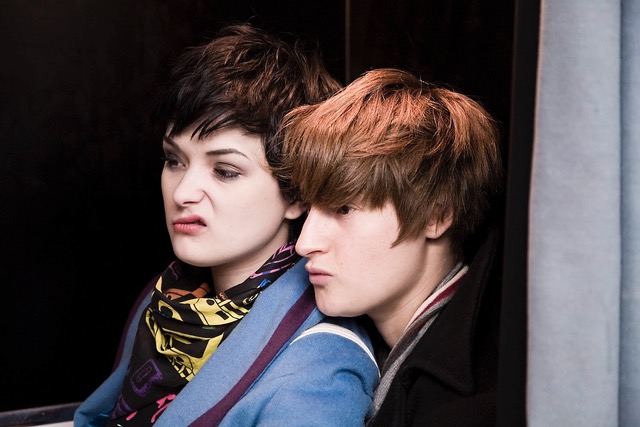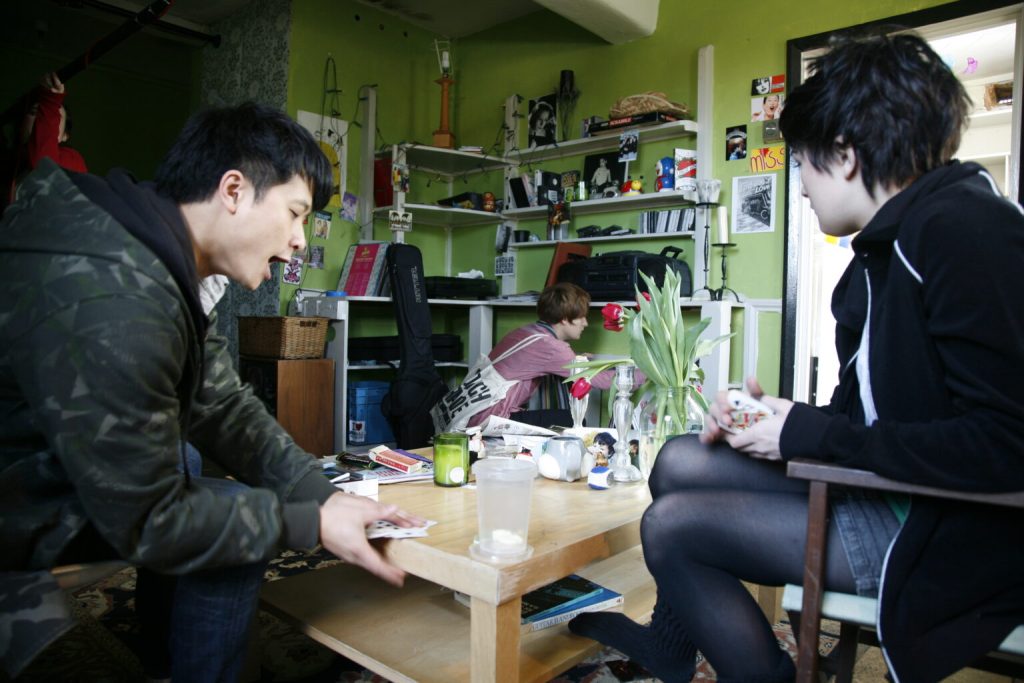By Ros Murray
Club des Femmes are hosting a screening of the director’s cut of Break My Fall (Redux) at Rio Cinema, Sunday 26 February 2023, 3pm, with a live, in-person Q&A with writer/director Kanchi Wichmann in conversation with Sam McBean. Book your tickets now! Use promo code CDFXBMF2023 on the payment page to get £4 off your full-price ticket!

Watch out for news from Peccadillo about the Redux release this Spring! All images from Kanchi Wichmann, Break My Fall (2011).
*
Writing for one of the first issues of the feminist film journal Another Gaze, Break My Fall writer-director Kanchi Wichmann notes: ‘lesbians will only support our own [film] culture when it’s been endorsed and sold back to us by the straight world’. Her words in her article ‘Lesbian Films Don’t Make Money’ resonate clearly in my mind as I come to write this piece. Yet we know that we need DIY lesbian filmmaking – lesbian films made by and for lesbians – and so cherish those few films that captured the spirit of a particular place at a particular time. For me, as for many of my friends, lesbian film culture means Go Fish (Rose Troche, 1994) and The Watermelon Woman (Cheryl Dunye, 1996), more recently revisited with The Owls (Cheryl Dunye, 2010) and its great making-of documentary Hooters (Anna Margarita Albelo). I revelled in the hilarious clumsiness of Who’s Afraid of Vagina Wolf (Anna Margarita Albelo, 2013).
I wished I was there when I saw Catalan filmmaker Marta Balletbò-Coll’s queer version of Barcelona and the Costa Brava in Costa Brava (1995). I want to be friends with everyone in Zaida Carmona’s Girlfriends/La Amiga de Mi Amiga (2022). It’s those films made on a shoestring budget by friends, perhaps even for friends, that show us how we are, how we want to be or don’t want to be; those films that have something to do with the lives that we live. It’s not Blue is the Warmest Colour (Abdellatif Kechiche, 2013), Carol (Todd Haynes, 2015) or The Kids are Alright (Lisa Cholodenko, 2010). It’s Chantal Akerman’s Je tu il elle (1974): it’s failure, disappointment, depression, awkward sex scenes that go on for too long, and journeys that don’t go anywhere.

Break My Fall provides the perfect antidote to the glossy over-privileged sunniness of The L-Word, that barometer of lesbian success as seen from the point of view of the straight world. Unlike some of the films I mentioned before, Break My Fall is not about lesbian community, but lesbian isolation. In the film shot over 16 days in November 2009, the protagonists Liza (Kat Redstone) and Sally Sellout (Sophie Anderson) have no lesbian friends, are not particularly likeable, and don’t even seem to like each other. Accompanied in the film by two boys – rent-boy Vin (Kai Brandon-Ly) and gay friend Jamie (Colin Clay-Chance) – they take too many drugs, drink too much, turn up late for work to their shitty jobs, and seem to have very little chance for (normative) success in their relationship, their band or their lives.
It’s a film that also seems to announce its own inevitable commercial failure – a first lesbian feature for Wichmann that focuses on the last three days of an abusive relationship, with a distinctly pessimistic edge borne out in grey tones, emphasising hangovers and the dreariness of the morning after. Even as characters get high, they seem to be crashing, and it captures the emotional tone of the end of a relationship as well as the spirit of East London on its dull days, where dark clouds hang low. In its portrayal of Hackney at that time, the only glimpse of queer community we get is a visit to everyone’s favourite feminist sex shop Sh! [now online only], and a trip south of the river to the Royal Vauxhall Tavern.
But the best scenes are shot in a greasy spoon – Dino’s Grill – from which Liza is ejected over an argument about a spare fork; and in the flat where Liza and Sally are surrounded by their lesbian clutter (and I’m thinking here of Laura Guy’s brilliant analysis in her PhD [PDF] of lesbian clutter vs sleek gay minimalism, in her attention to the gentrification of New York and the place of lesbian archives): tapes, jiffy bags, unwashed mugs, ashtrays, Claude Cahun on the bookshelf, a Doraemon clock, fairy lights, videotapes, LPs, candlesticks, a copy of the Hackney Gazette.

The locations in the film are believable and precise: Grill & Spice on Lea Bridge Road, Rough Trade East record shop off Brick Lane. It’s surely no coincidence that in the opening sequence we get not only an establishing shot of the estate where the Liza and Sally live but also, à la Akerman, the full address – 26 Milstead House, Pembury Road, E5 8JT – scrawled on an envelope from a lover in Berlin. They are not only filmed surrounded by mess, but also in a deliberately messy style – handheld shaky camera movements with some fantastically wobbly framing, uncomfortable close-ups, and shots like, for example, the moment where the couple riding bikes are filmed from what seems to be a bike itself.
The soundtrack equally locates the protagonists at a precise moment, and reminds me of the era’s venues like the local hangout Power Lunches before it was forced to close, pushed out by rent increases. Many of the people in the soundtrack bands, who hung out in those spaces, have now moved out not only of Hackney but of London altogether. The brilliantly selected East London queer DIY music scene and its affiliates is captured so nicely, and probably unintelligible to people who weren’t there at the time. Bands like Wet Dog, Plug, and Peggy Sue, as well as more well-known bands like Micachu and the Shapes and Scout Niblett, generate the soundtrack that really drives the film forward. There’s a delightfully implausible scene where Liza goes home with a hot professional butch (played by Chéo Rhodes) with a fast car and swanky flat, only to find, in this pristine environment, a record player and set of LPs complete with a vinyl copy of The Raincoats’ eponymous début, which Liza promptly pulls out and puts on. She chooses the song ‘Off Duty Trip’, and its chorus ‘Join the professionals!’ takes on a new meaning. It’s surely every self-respecting lesbian’s ultimate fantasy: to find a Raincoats record in this scenario.

If Break My Fall seems uninterested in providing an optimistic celebration of queer community, it’s because it appeals to that equally important side of us that wallows in lesbian melancholia, in queer anti-sociability and failure, and defining, at least for me, the spirit of our times. It doesn’t even really present us with a ‘scene’, but, as Wichmann herself points out in an interview in the Hackney Citizen in 2011, a ‘ “behind-the-scenes” of a scene’. We don’t get any gigs, except briefly mediated through recorded footage that Liza watches on her laptop, before throwing it off the roof in a fit of jealous despair. We get rehearsals where the characters are unable to play, and can’t get through a song, echoed on the soundtrack by the fragments of songs, a minimal bassline and guitar riff that resonate alongside the characters’ inability to communicate effectively (not to mention the amount of complete silence in the film).
It’s got a distinctly nostalgic feel to it – in part due to being shot entirely on 16mm – but it’s also about new beginnings. The most uplifting moment – and the only real event that happens in the film – is the decision, right at the end, that Liza takes to leave. But even then, it takes place at the Shell service station at dusk or dawn (hard to know in a film shot in the UK in winter about almost exclusively nocturnal characters), with the claustrophobic close-up switching to a liberating longshot of a dreary English motorway… I, for one, am a huge fan.
Down with positive representation and self-congratulation, up with sticking two fingers up to the straight world! Up with lesbians supporting lesbian culture. As Peggy Sue sing in ‘First Aid/Once We Were Strangers’: ‘ohhhhhh bring it back to life / if I would only try / if I would only try’.
